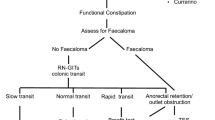Abstract
Purpose
Slow transit constipation (STC) and functional fecal retention (FFR) are two forms of severe intractable constipation in childhood diagnosed by nuclear transit studies (NTS). This retrospective study aims to identify the predicting factors for STC and FFR by looking at the association with neuropsychiatric disorders (NPD), obesity, family history of constipation and atopic disease.
Patients and methods
A retrospective chart review was conducted on children with intractable constipation referred for NTS between 1st April 2003 and 1st April 2014. Comparisons were made between STC, FFR and normal transit patients with regards to NPD, obesity (BMI z score >95th percentile), family history of constipation in first and second-degree relatives and atopic disease which included food allergy, asthma and eczema.
Results
Between 2003 and 2014, 97 patients were referred for a NTS. Out of 36 patients with NPD, 21 (58.3 %) had STC and 13 (36.1 %) had FFR (p < 0.05). 15.8 % of patients with constipation were obese, compared to 6.4 % in the general Australian paediatric population (p < 0.05). There was no significant association between constipation and atopic disease or family history.
Conclusion
Neuropsychiatric disorders, in particular autism, are useful predictors of STC and FFR in children. Obesity may be associated with a higher risk of developing chronic constipation.

Similar content being viewed by others
References
van den Berg MM, Benninga MA, Di Lorenzo C (2006) Epidemiology of childhood constipation: a systematic review. Am J gastroenterol 101(10):2401–2409. doi:10.1111/j.1572-0241.2006.00771.x
Shin YM, Southwell BR, Stanton MP, Hutson JM (2002) Signs and symptoms of slow-transit constipation versus functional retention. J Pediatr Surg 37(12):1762–1765. doi:10.1053/jpsu.2002.36716
Hutson JM, McNamara J, Gibb S, Shin YM (2001) Slow transit constipation in children. J Paediatr Child Health 37(5):426–430
Yik YI, Cain TM, Tudball CF, Cook DJ, Southwell BR, Hutson JM (2011) Nuclear transit studies of patients with intractable chronic constipation reveal a subgroup with rapid proximal colonic transit. J Pediatr Surg 46(7):1406–1411. doi:10.1016/j.jpedsurg.2011.02.049
Yik YI, Ismail KA, Hutson JM, Southwell BR (2012) Home transcutaneous electrical stimulation to treat children with slow-transit constipation. J Pediatr Surg 47(6):1285–1290
Rao SSC, Meduri K (2011) What is necessary to diagnose constipation? Best Pract Res Clin Gastroenterol 25(1):127–140. doi:10.1016/j.bpg.2010.11.001
Williams K, Glasson EJ, Wray J, Tuck M, Tuck M, Helmer M, Bower CI, Mellis CM (2005) Incidence of autism spectrum disorders in children in two Australian states. Med J Aust 182:108–111
Pang KH, Croaker GD (2011) Constipation in children with autism and autistic spectrum disorder. Pediatr Surg Int 27(4):353–358. doi:10.1007/s00383-010-2680-8
Pashankar DS, Loening-Baucke V (2005) Increased prevalence of obesity in children with functional constipation evaluated in an academic medical center. Pediatrics 116(3):e377–e380. doi:10.1542/peds.2005-0490
Abrahamian FP, Lloyd-Still JD (1984) Chronic constipation in childhood: a longitudinal study of 186 patients. J Pediatr Gastroenterol Nutr 3(3):460–467
Syrigou EI, Pitsios C, Panagiotou I, Chouliaras G, Kitsiou S, Kanariou M, Roma-Giannikou E (2011) Food allergy-related paediatric constipation: the usefulness of atopy patch test. Eur J Pediatr 170(9):1173–1178. doi:10.1007/s00431-011-1417-6
Osatakul S, Puetpaiboon A (2014) Use of Rome II versus Rome III criteria for diagnosis of functional constipation in young children. Pediatr Int 56(1):83–88. doi:10.1111/ped.12194
Lewis SJ, Heaton KW (1997) Stool form scale as a useful guide to intestinal transit time. Scand J Gastroenterol 32(9):920–924. doi:10.3109/00365529709011203
American Psychiatric Association, Task Force on DSM-IV (1994) Diagnostic and statistical manual of mental disorders : DSM-IV, 4th edn. American Psychiatric Association, Washington, DC
Katherine M, Flegal TJC (2013) Construction of LMS parameters for the centers for disease control and prevention 2000 growth charts (trans: Services UDoHaH). National Health Statistics Reports
Scott J, Ng S, Cobiac L (2012) The relationship between breastfeeding and weight status in a national sample of Australian children and adolescents. BMC Public Health 12(1):107
Croaker GD, Pearce R, Li J, Nahon I, Javaid A, Kecskes Z (2007) Idiopathic slow transit constipation is rare. But delayed passage of meconium is common in the constipation clinic. Pediatr Surg Int 23(12):1153–1159. doi:10.1007/s00383-007-2021-8
Yik YI, Farmer PJ, King SK, Chow CW, Hutson JM, Southwell BR (2011) Gender differences in reduced substance P (SP) in children with slow-transit constipation. Pediatr Surg Int 27(7):699–704. doi:10.1007/s00383-011-2852-1
Knowles CH, Scott SM, Rayner C, Glia A, Lindberg G, Kamm MA, Lunniss PJ (2003) Idiopathic slow-transit constipation: an almost exclusively female disorder. Dis Colon Rectum 46(12):1716–1717. doi:10.1097/01.dcr.0000098929.52147.b8
Preston DM, Lennard-Jones JE (1986) Severe chronic constipation of young women: ‘idiopathic slow transit constipation’. Gut 27(1):41–48
de Theije CG, Wu J, da Silva SL, Kamphuis PJ, Garssen J, Korte SM, Kraneveld AD (2011) Pathways underlying the gut-to-brain connection in autism spectrum disorders as future targets for disease management. Eur J Pharmacol 668(Suppl 1):S70–S80. doi:10.1016/j.ejphar.2011.07.013
Iacono G, Cavataio F, Montalto G, Florena A, Tumminello M, Soresi M, Notarbartolo A, Carroccio A (1998) Intolerance of cow’s milk and chronic constipation in children. N Engl J Med 339(16):1100–1104. doi:10.1056/NEJM199810153391602
Fishman L, Lenders C, Fortunato C, Noonan C, Nurko S (2004) Increased prevalence of constipation and fecal soiling in a population of obese children. J Pediatr 145(2):253–254. doi:10.1016/j.jpeds.2004.04.022
Huang R, Ho SY, Lo WS, Lam TH (2014) Physical activity and constipation in Hong Kong adolescents. PLoS One 9(2):e90193. doi:10.1371/journal.pone.0090193
Benninga MABHSCGFBP (1995) Defaecation disorders in children, colonic transit time versus the Barr-score. Eur J Pediatr 154(4):227–284
Pacgb IW (1994) The clinical value of solid marker transit studies in childhood constipation and soiling. Eur J Pediatr 153(8):560–564
Author information
Authors and Affiliations
Corresponding author
Rights and permissions
About this article
Cite this article
Ridha, Z., Quinn, R. & Croaker, G.D.H. Predictors of slow colonic transit in children. Pediatr Surg Int 31, 137–142 (2015). https://doi.org/10.1007/s00383-014-3651-2
Accepted:
Published:
Issue Date:
DOI: https://doi.org/10.1007/s00383-014-3651-2




